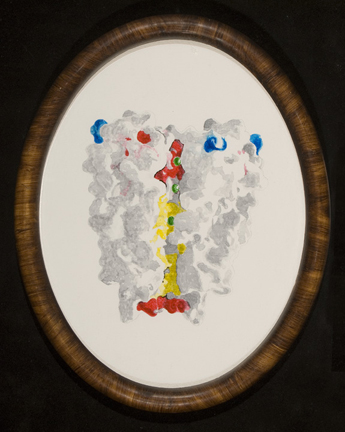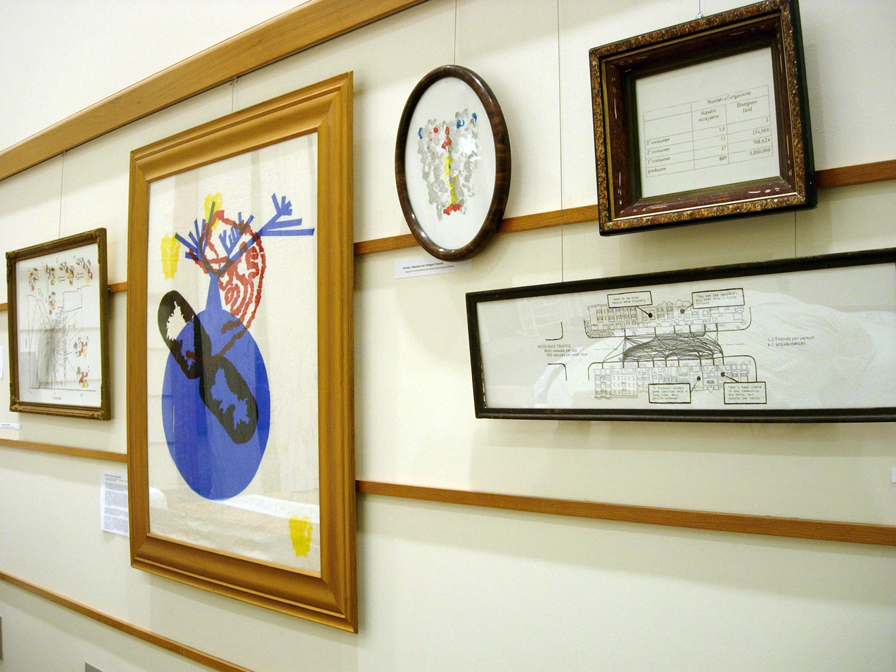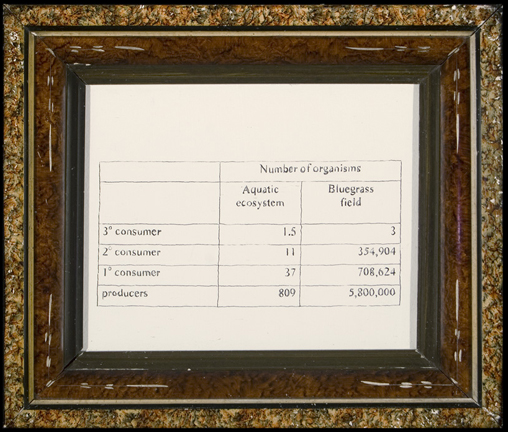detail of daily life
Hierarchy of Genres
Still Life (Vanitas): Biomass Pyramid
Black Sharpie Marker on Gesso'd Paper, 12.25"x14.5"
Image Submitted by Jeff Scott. This piece winks. It takes a biomass pyramid - a snapshop of time in an ecological community and links it to the transience of life associated with vanitas style still life paintings. I particularly like the sparseness of my still life, where the numbers tell of the impermanance in the sumptuous arrangements of plant and animal life.
Definition of Biomass Pyramids from Wiki:
Biomass p yramids provide a single snapshot in time of an ecological community.
In an ecosystem there is always a foundation species of plant that directly harvests energy from the sun, for example, grass, by the process of photosynthesis. Next are herbivores (primary consumers) that eat the grass, such as the rabbit. Next are carnivores (secondary consumers) that eat the rabbit, such as a bobcat.
Since each layer of this system relates to the one below it by absorbing a fraction of the energy it consumed, each one can be understood as resting on the one below -- which is called a lower trophic level. Every time there is an exchange of energy between one trophic level and another, there is quite a significant loss due to the fundamental laws of thermodynamics. This means so many units of grass can only support a much smaller number of units of rabbits, who can only support a smaller group of bobcats, who can only support a smaller group of mountain lions.
When energy is transferred to the next trophic level, typically only 10% of it is used to build new biomass, becoming stored energy. The other 90% is used for the organisms life processes or is lost as heat to the environment. As such, each step will be 10% the size of the previous step (100, 10, 1, 0.1, 0.01, 0.001 etc.).
Funny?
This project is very funny to me. Perhaps I'm a science geek, but the ion transport channel featured as the 'portrait' is key to understanding this series. Ion transport channels are essential agents of our cognizance. From sensory perception to memory, the evolution of ion transport channels set up a polarity in cells that allows our neuronal system to send signals/messages, and ultimately are necessary components enabling story telling. Without the ion transport channels (and other compounding systems) we would not be able to narrate the phenomenon of the world - be it religious, artistic or scientific.
Acknowledgements:
Janet McCue, Meg Jamieson and Nancy Wightman for donating appropriate frames. John Nosewicz for constructing the frame for Garden. NKD Norway for residency to make Garden of Eden. MacDowell colony where I started the series with Protein Landscape in Shop studio.
Installation view, Bissel Gallery, Mann Library
Petit Genre: Daily Life
Black Sharpie on Gesso'd paper9"x31.5"
Taken from an anonymous submission, this is an image from a book called "Humanscapes - environments for people" edited by Stephan and Rachel Kaplan, pg 247. The particular pages selected are about how traffic intensity affects community relations between those living on the street.
Portrait: Ion Transport Channel
Acrylics on Gesso'd paper, 15"x12"
This is an image submitted by Carl Hopkins. It is of a protein called an ion transport channel published in Science. It is responsible for so much of what we call life - from muscles contracting, to memory, to sensing the environment.
Landscape: Protein Landscape
Acrylics on Gesso'd paper, 22.5"x30.5", started October 2006 at MacDowell, completed August 2007.
Drawn from the submissions by David Shalloway, this is a depiction of a "protein potential energy landscape."
Grande Genre - Allegory: Garden of Eden
Collograph, relief printing ink on cotton muslin. R Domeij Printing Press, Stockholm. 47"x39" , Bygstad, Norway, August 2007
This piece was first shown opposite and installation by Michael Johannson in the barn galleries of Åmot Gaard for the opera weekend. Please visit the Garden to learn more about the graphics.
variable materials
Ithaca, NY USA
Installed for the first time together at the Bissel Gallery as part of Copying the Masters, scientific graphics are framed as contemporary examples of the Hierarchy of Genres(wiki): grande genre (allegory), petit genre (daily life), portrait, landscape, and still life.
Building on the Visualizing Meaning and Vector projects, images selected as important or meaningful visual representations of data by Cornell Faculty are recontextualized to create a play on genres for scientific storytelling. This project was a playful rearticulation of Allegory (scientific depiction of the Garden of Eden), Daily Life (impact of lanes of traffic on social relations), Portrait (ion transport channel as a notable figure), Landscape (visualization of a protein landscape), Still Life (an ecological interpretation of a vanitas style still life).






